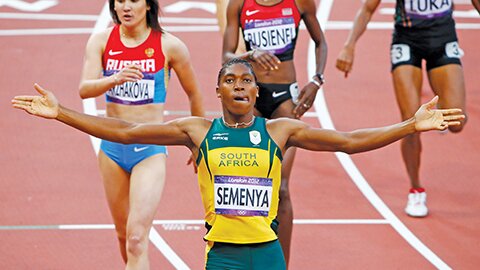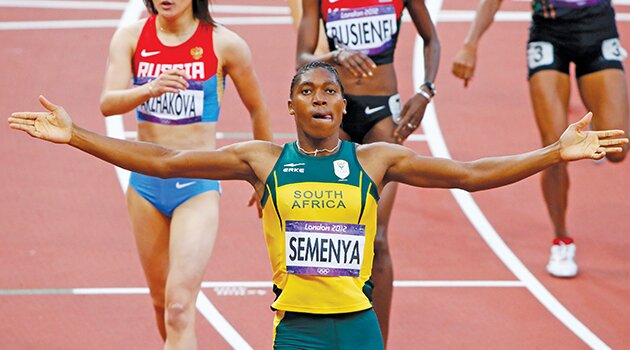Semenya criticism not scientific


Mokgadi Caster Semenya … The first black South African woman to win a world track title when she stormed to 800m gold in Berlin seven years ago. (File Pic)
Some critics have suggested that Mokgadi Caster Semenya should not be allowed to race against women as she might have an “unfair advantage” over other competitors because of her alleged high testosterone levels. As the claim appears not to be scientifically justified, the suspicion arises that the objections are informed by prejudice and by stereotypical assumptions about women (and in this case, specifically, a black woman), writes Pierre de Vos:
After South Africa’s Caster Semenya won the 800m at the world athletic championships in 2009, Caster Semenya was humiliated by the International Association of Athletics Federations (IAAF) which ordered her to undergo the bizarrely named “gender verification test”. (Can it be that none of its members understand the difference between sex and gender?)
In 2011, and in response to the controversy it stirred up around Semenya, the IAAF announced a new rule that allowed women only to compete in women’s events if their testosterone levels were “below the male range”.
However, this rule was challenged and in 2015 the Court of Arbitration for Sport (CAS) upheld Indian sprinter Dutee Chand’s appeal against the rule.
The decision is important because it was partly based on the fact that there was no convincing scientific evidence that women with elevated testosterone levels had an “unfair” performance advantage over others. (It is unclear what might constitute an “unfair” advantage and how one might determine this.)
As Peter Sonksen and Daryl Adair pointed out in a recent article, a study investigating the hormone profiles of female and male athletes found that the IAAF rule was based on bogus science.
This study measured hormone profiles, including testosterone, from a sample of 693 elite athletes across 15 sporting categories. The authors note that many unexpected findings emerged in the study, such as that “16.5% of men had a testosterone level below 8.4 nanomole per litre (the lower limit of the normal male reference range). Some were unmeasurably low.
And 13.7 percent of the elite female athletes had a level higher than 2.7nmol/l, the upper limit of the normal reference range for women. Some were in the high male range.
Thus, there was a complete overlap of testosterone levels between male and female elite athletes. This challenged existing knowledge, which had assumed there was no such overlap.”
I therefore contend that many of Semenya’s critics (and critics of other women athletes who do not conform perfectly to the deeply entrenched stereotypical notion of how women are supposed to look) are not in the first instance advancing a scientific argument.
They might use “scientific language”, but they are almost certainly channelling (perhaps even without knowing that they are doing this) their deeply entrenched social beliefs about women: about what in essence makes somebody a woman; about how they think women are supposed to look, about how they think women should behave. (If I wanted to put on my academic cap and sound clever, I would note that the disciplining male gaze is ever present in all of this.)
Athletes excel for many reasons. Biological or genetic characteristics give some athletes an advantage over others, but these are celebrated “as a source of inborn excellence” – as Silvia Camporesi recently pointed out.
Why then single out testosterone levels in women when there is no clear evidence that high levels of testosterone in women’s bodies give them an “unfair advantage” over other women?
Caster has a gift. But because that gift comes in a package that disturbs stereotypical assumptions about women, some cannot acknowledge it as a gift, but must invent a reason to argue that she should be disqualified from competing.
What makes the attacks on her even more egregious is that they are often highly personal, and based on shockingly ignorant views of biology and identity. The attacks also directly and indirectly rely on and promote gender stereotypes.
We live in a patriarchal world, in which gender stereotypes are not always properly identified as stereotypes.
The patriarchal culture is so deeply invested in promoting and policing these stereotypes and so invested in these stereotypes being accepted as “normal” or as “natural” – as just the way the world is – that people are more often than not convinced that the toxic stereotypes they rely on are nothing more than “common sense” about sex and gender.
When you do not conform to the fictional “common sense” expectations of society – if you are a femme man or a butch woman or otherwise gender non-conforming; if you are a feminist among patriarchs; if you do not essentialise identity – you will face many challenges because your very existence threatens the status quo.
Mokgadi Caster Semenyaexperienced this first-hand. Yet, she came back and – fingers crossed – is on the brink of Olympic greatness.
Maybe this is a moment for us as a society so deeply invested in a patriarchal idea of what a “normal” or “natural” woman is, and how such a woman should behave, to reflect on the importance of respecting individuals who do not conform to gender stereotypes (or any other stereotype associated with race, sex, sexual orientation, language or ability).
Why is it that so many people are deeply invested in the idea that all humans can and must be neatly fitted into discrete boxes (black/white; male/female; gay and lesbian/straight; cisgender/transgender)?
Why do so many people truly believe that these boxes tell an essential truth about those who “belong” in them?
Many people think and talk about sex and gender as if these categories – with their strictly policed boundaries (who act as the police officers?) – are so obvious, so naturally true, so accurate about every person, so fixed, that it is not worth talking about.
But, of course, these boxes – identity categories if you will – are not “natural”, not “self-evident”, not “common sense”. They are constructed, perhaps partly to make the world simpler and safer. (I almost added, “safer for patriarchy”.)
Jorge Luis Borges illustrated in a playful way the often arbitrary and culturally specific way in which humans make classifications – what boxes we believe things and people must be put in and what rules we use to put things and people in these boxes.
Borges invented an ancient Chinese encyclopaedia entitled Celestial Emporium of Benevolent Knowledge in which, he claimed, animals were classified as follows:
“Those that belong to the emperor; embalmed ones; those that are trained; sucking pigs; mermaids (or sirens); fabulous ones; stray dogs; those that are included in this classification; those that tremble as if they were mad; innumerable ones; those drawn with a very fine camel hair brush; et cetera; those that have just broken the flower vase; those that, at a distance, resemble flies.”
The point being, of course, that we classify people and use rules to do so that might make sense to us now but that future generations might not understand.
Often the classification has a political aim: to subjugate, exploit and oppress and to control society to serve the needs of those who hold power.
I am suggesting that the original decision by the IAAF that women could only compete in the sport if their testosterone levels were “below the male range” was an attempt by the body to impose its highly problematic and stereotypical view of who can be a woman and who are not allowed to be thought of as a woman.
I would suggest it did this (probably without knowing it) because of its fears and anxiety about gender non-conforming athletes.
(It is telling that the IAAF ordered Semenya to do a “gender verification test”, when what was supposedly in issue was not her gender but her biological sex.)
One may also ask why the IAAF only reacted when Semenya burst onto the scene. Before Caster, many woman athletes from the US and Europe competed despite not perfectly conforming to the toxic stereotype of how a woman “ought to look”.
One could possibly write an entire thesis about how Semenya’s race as a black African impacted on the response of the IAAF to her winning the world championships.
What is clear is that there was no scientific basis for the original rule made by the IAAF.
Given that categories like “sex” and “gender” are constructed, and given that it is not really biologically or psychologically tenable to subdivide the category of “sex” into only two options – male/female – any rules imposed by the IAAF would risk being entirely arbitrary.
Although most people take the binary man/women for granted, it does not fully capture the psychological and physical reality of many people.
Even if we accept the fiction that society is neatly divided between “men” and “women” (something that is obviously not true), there must be at least a dozen different ways of determining the sex of a person.
How would the Olympic Committee decide which method (or combination of methods) should be used to determine whether an athlete is a “real” woman who does not have an “unfair advantage” over others?
Whose interest will be served by these choices? (My guess is, if given a chance, the IAAF will choose the markers that will keep its sponsors happy, but I hope that this is too cynical.)
Caster Semenya’s success – and the hateful people who unthinkingly invoke different stereotypes, or deploy the power of a certain medical discourse to try to delegitimise her achievements – call on all of us to think again about whether it is wise to talk with such certainty about the identity categories we rely on to get us through the day.
Maybe it is time to have a conversation about why these categories are not absolutely fixed; why they do not tell the complete truth about any human being: why they can never encompass the infinitely diverse ways in which we make our way in the world.- DM
De Vos teaches constitutional law at the University of Cape Town Law Faculty, where he serves as deputy dean and as the Claude Leon Foundation Chair in Constitutional Governance.
